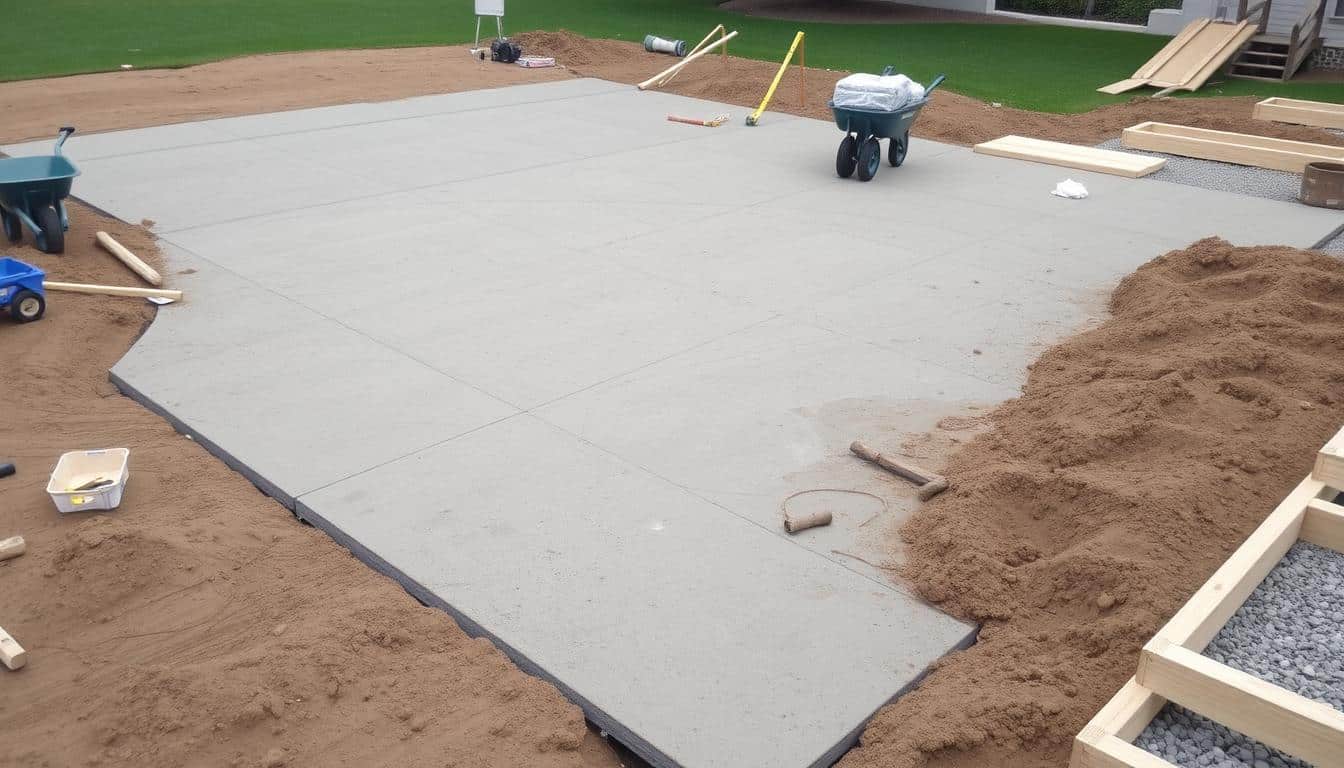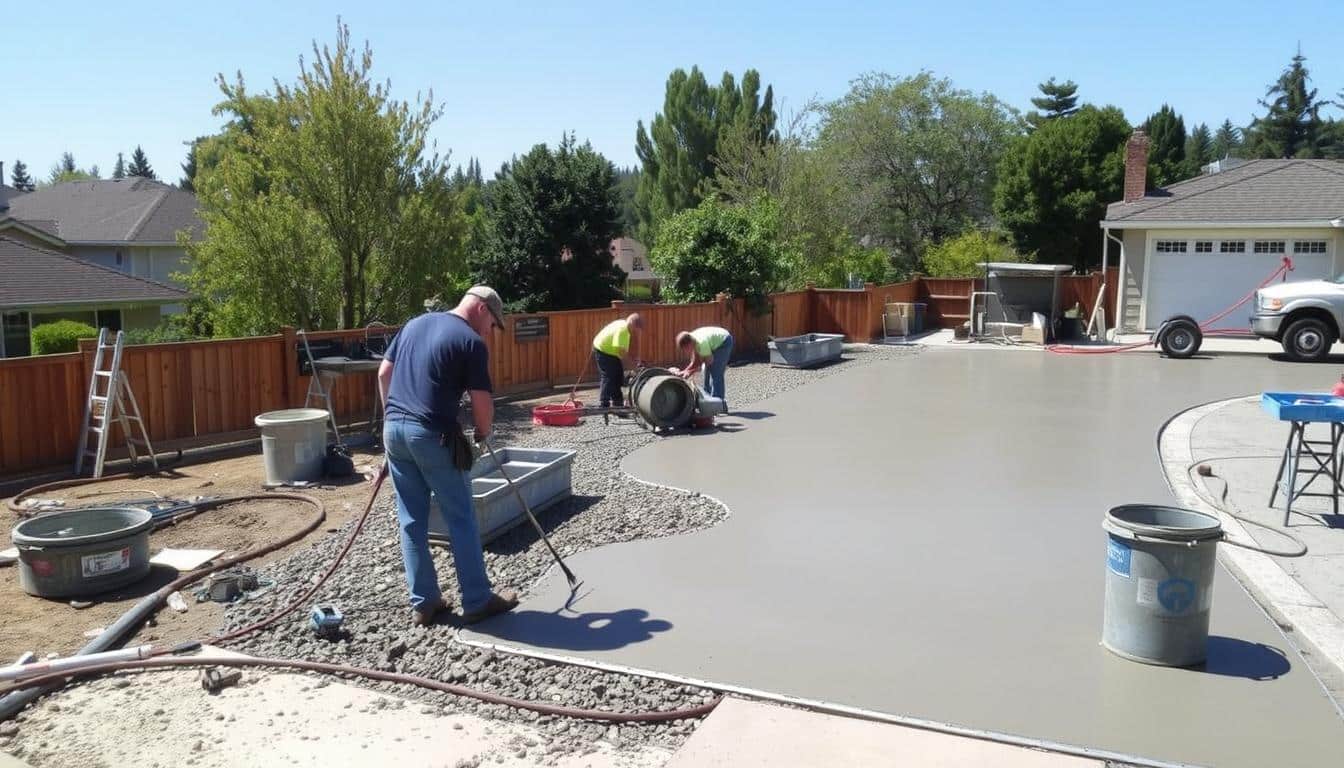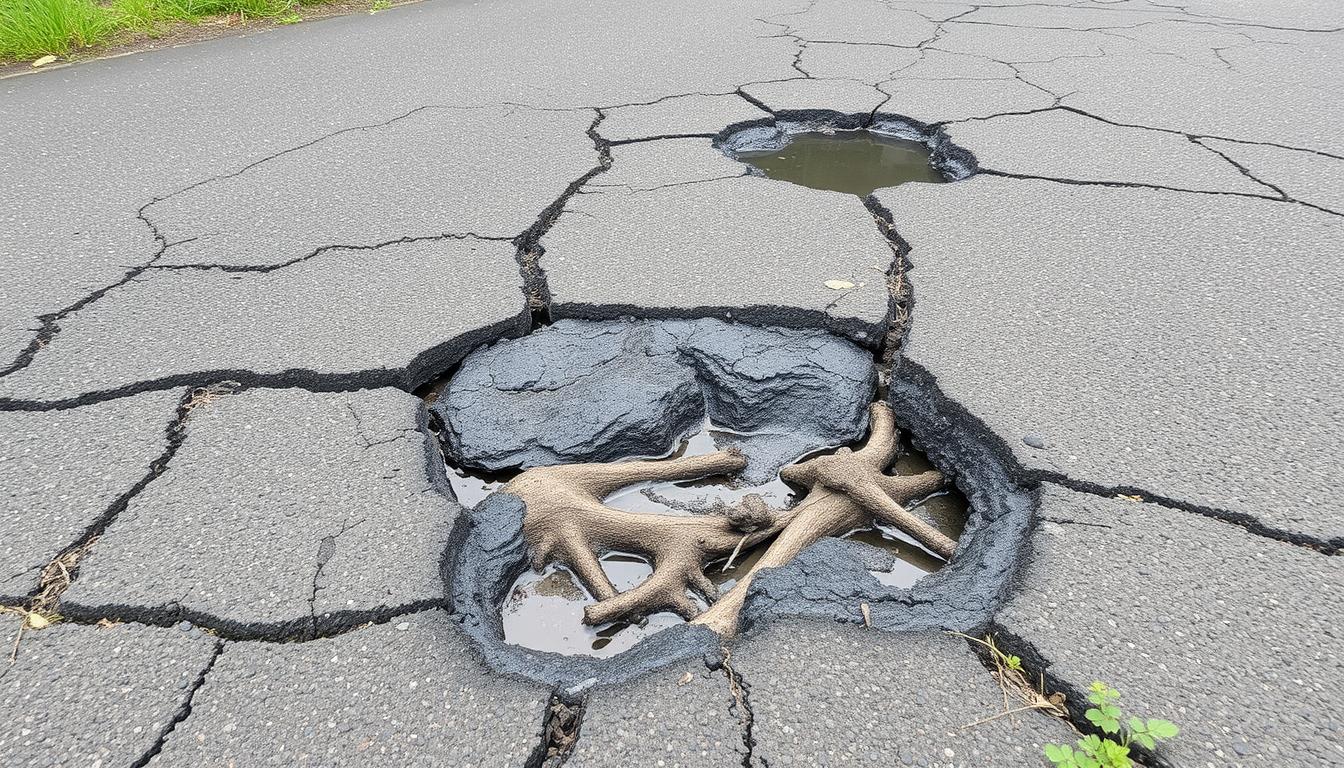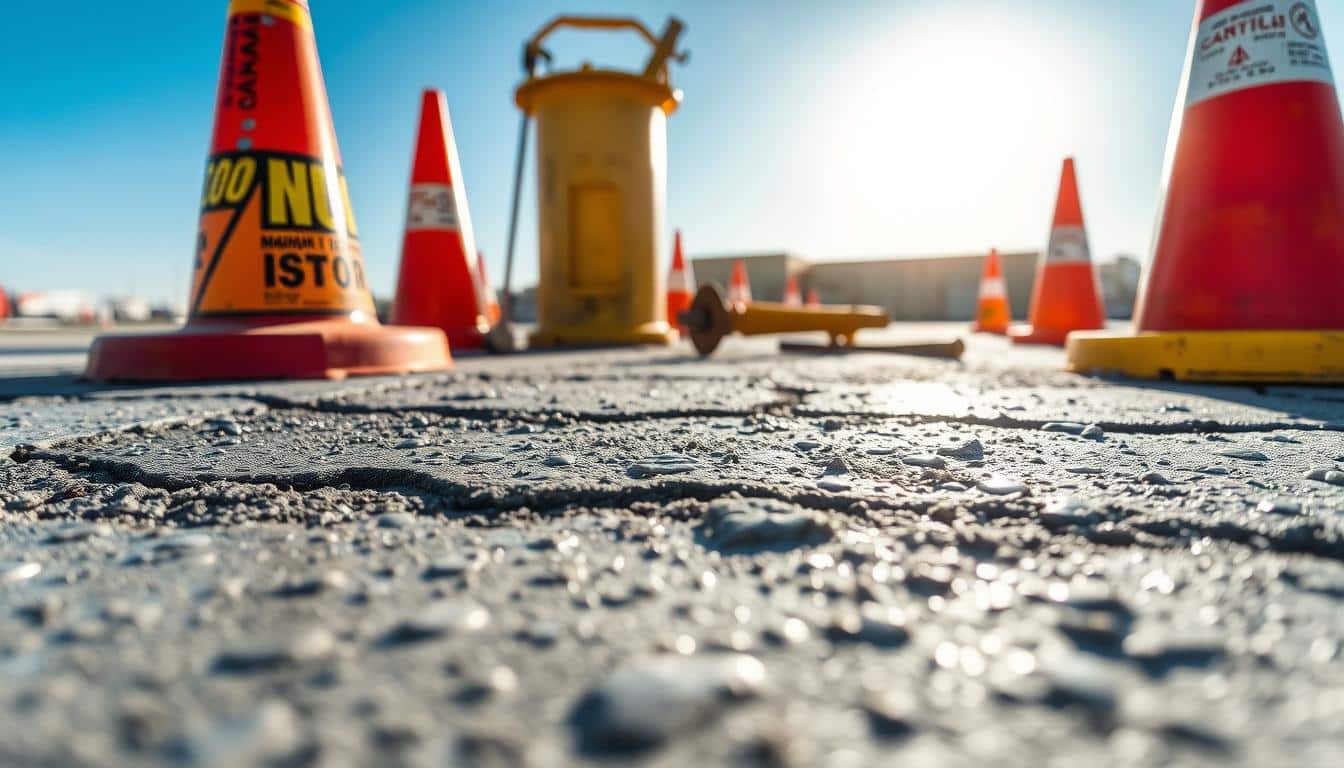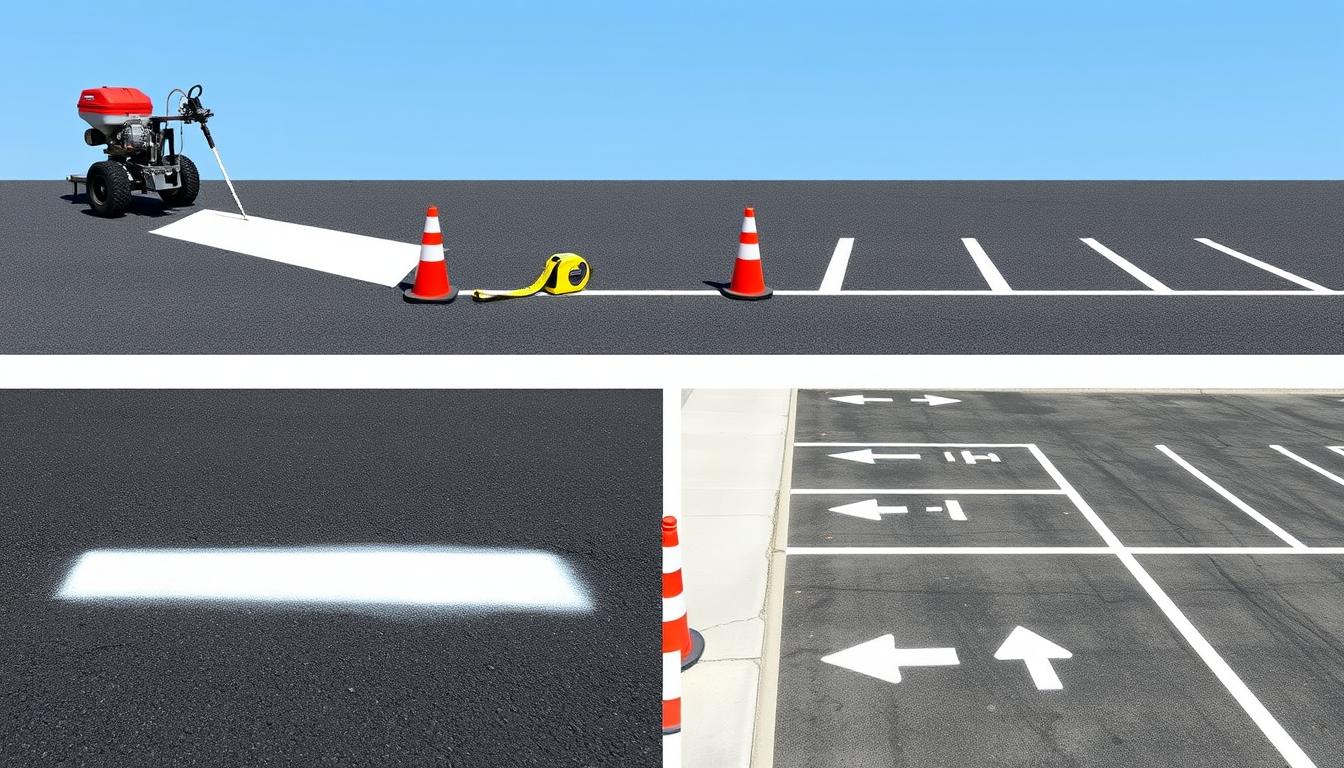How is Concrete Installed for Driveways, Patios, and Sidewalks? Or why some last decades while others crack quickly? The secret lies in the concrete installation process. It’s more than just pouring a mix; it involves careful planning and techniques.
At HT Paving and Seal Coating Services, we provide top residential concrete services. They make your outdoor spaces both functional and beautiful.
This article will guide you through the concrete installation steps. It shows why it’s a key investment for your property.
Key Takeaways
- Proper concrete installation significantly impacts durability and maintenance.
- Concrete mix ratios vary depending on the intended use, such as 1:2:4 for sidewalks.
- A typical sidewalk slab thickness is 4 inches; driveways require about 6 inches.
- Regular maintenance, including sealing, greatly extends concrete lifespan.
- Expansion joints are critical to prevent cracking due to temperature changes.
The Importance of Proper Concrete Installation
Getting concrete installed right is key for a lasting, strong surface. It brings many benefits, like lasting longer and needing less upkeep. Concrete can handle a lot of use and look good doing it, making it a top pick for homes.
Benefits of a Well-Installed Concrete Surface
Proper concrete installation means your surface can last over 30 years with some care. It beats out asphalt and gravel, which need more fixes. Concrete also needs only occasional cleaning and sealant every 3 to 5 years.
Well-installed concrete can even boost your home’s value by up to 15%. It looks better and offers many design options. Studies show it can handle loads up to 10,000 psi, perfect for heavy traffic.
Common Issues with Poor Installation
But, bad installation can cause big problems. Cracks, uneven areas, and water pooling can weaken the surface. This leads to expensive fixes and less appeal.
These issues shorten the surface’s life and raise upkeep costs. Poor drainage can cause it to wear out faster. Regular care is vital, but bad installation makes it harder.
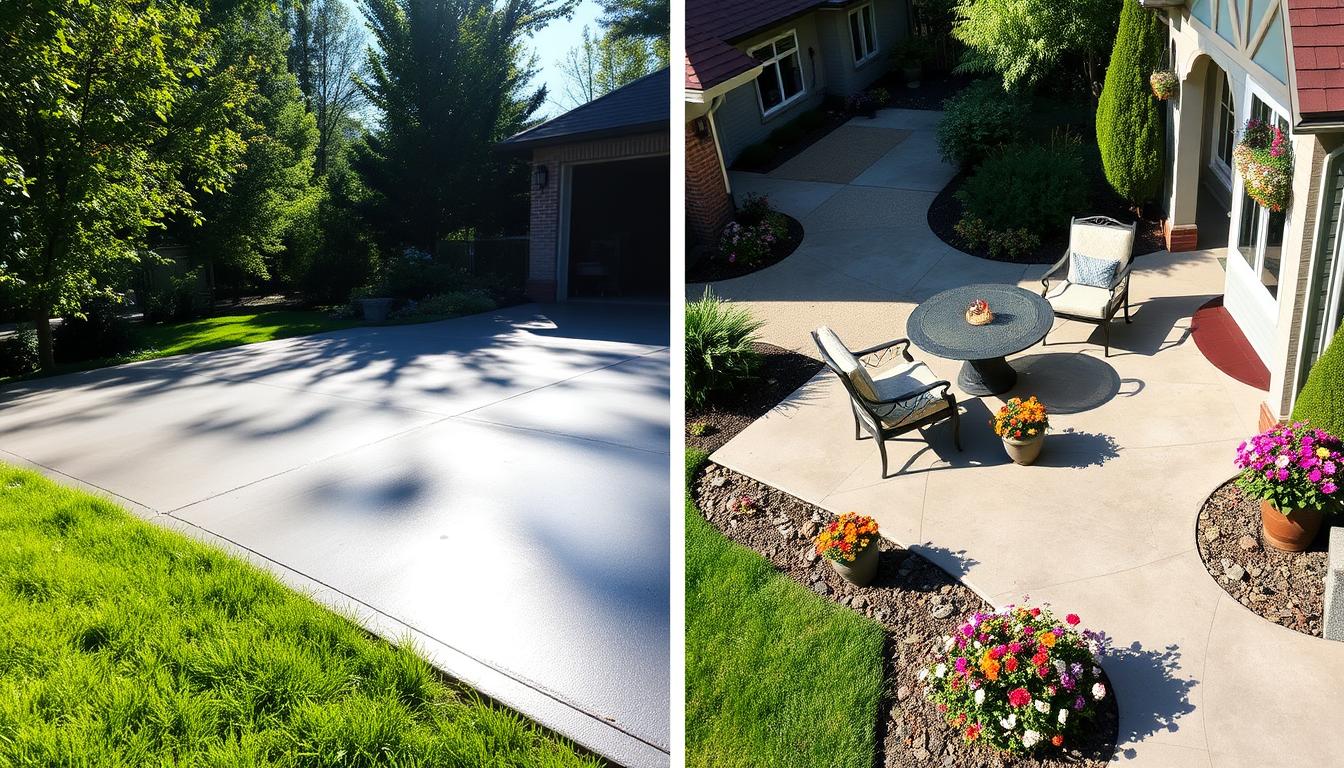
Preparing the Site for Concrete Work
Site preparation is essential for a successful concrete job. It begins with a detailed site assessment. This includes checking drainage and soil stability.
Removing vegetation, tree roots, or debris is also important. It ensures a smooth process.
Assessing the Location and Conditions
Start with a thorough site assessment. Look for nearby structures, slopes, or features that could affect the concrete. Soil quality is also important for the concrete’s durability.
Proper evaluation helps plan the clearing and grading needed. This ensures a stable base for the concrete paving.
Clearing and Grading the Area
After the assessment, it’s time for clearing and grading. This step makes the surface level and ready for the concrete. The goal is to remove any obstacles and improve load distribution.
For standard applications, a 4 to 6 inches compact base is needed. But, driveways and load-bearing slabs might need more depth, depending on the climate and soil. Proper grading also helps manage water drainage, which is essential for the concrete’s performance and longevity.
Choosing the Right Concrete Mix
Choosing the right concrete mix is key for durability and performance on different surfaces. The mix you pick depends on several factors, like the difference between driveway and patio concrete. Knowing these differences helps ensure your surfaces last long and resist wear.
Factors to Consider for Driveways vs. Patios
When picking a concrete mix, consider load-bearing capacity and environmental exposure. Driveways need a strong mix, around 4,000 psi, to handle vehicle loads. Patios, on the other hand, focus on looks and surface finish, needing a less strong mix.
Local weather in Greenville, SC, also plays a role. It affects how well the concrete mix lasts on your surfaces.
Understanding Concrete Strength and Composition
Concrete strength comes from its mix. A common mix is 1 part Portland cement, 1.5 parts gravel, and 1 part sand. This mix works well for many home projects.
For heavy loads, like foundations, high-strength concrete over 6,000 psi is used. For lighter structures, like walls, lightweight concrete is better. For more on retaining walls and materials, check this resource.
Choosing the right concrete mix ensures your outdoor spaces last long and don’t crack.
Formwork: The Framework for Success
Concrete formwork is key in building structures. It holds the concrete in place until it sets. Different materials can be used, each with its own benefits. The right choice affects the project’s cost and durability.
Materials Used for Formwork
Wood, steel, and plastic are common for formwork. Wood is easy to use and accessible. Steel is strong and durable, great for big projects. Plastic forms are light and can be reused, saving money.
Choosing the right formwork makes concrete installation smoother. It helps in achieving better results.
Importance of Accurate Measurements
Getting measurements right is vital for concrete projects. It ensures the structure fits perfectly. Any mistakes can cause problems later.
Good formwork is the base for quality concrete. It affects how the concrete looks and works. Paying attention to details here avoids future issues and ensures the structure lasts long.
Pouring Concrete: The Process Explained
The concrete pouring process is key for making driveways, patios, and sidewalks last. Learning the best techniques is important for a smooth finish and long-lasting results. A few practices can greatly improve the quality and strength of the final product.
Best Practices for Pouring Techniques
Working in small batches is a good method. It keeps the mixture consistent, which is important for big areas. Using a bull float helps spread the mixture evenly, creating a level surface.
Keeping the flow steady while pouring is also important. It helps avoid air bubbles that can weaken the concrete.
Timing and Weather Considerations
Timing is critical for successful concrete pouring. The best temperature is around 70°F, which helps the concrete cure well. If it’s colder than 50°F, you need to cure it for seven days.
It’s best to avoid pouring when it’s below 40°F to prevent cracks. Pouring on overcast days or in the cooler evening hours is better. This reduces the chance of the concrete curing too fast. Knowing the best weather conditions for pouring concrete leads to better results, making the installation strong and lasting.
Finishing the Concrete Surface
Finishing concrete surfaces involves several techniques. These methods enhance both the look and durability of the final product. After pouring, these techniques create a surface that looks good and works well. Different concrete finishes meet various needs and tastes, making projects in homes and businesses unique.
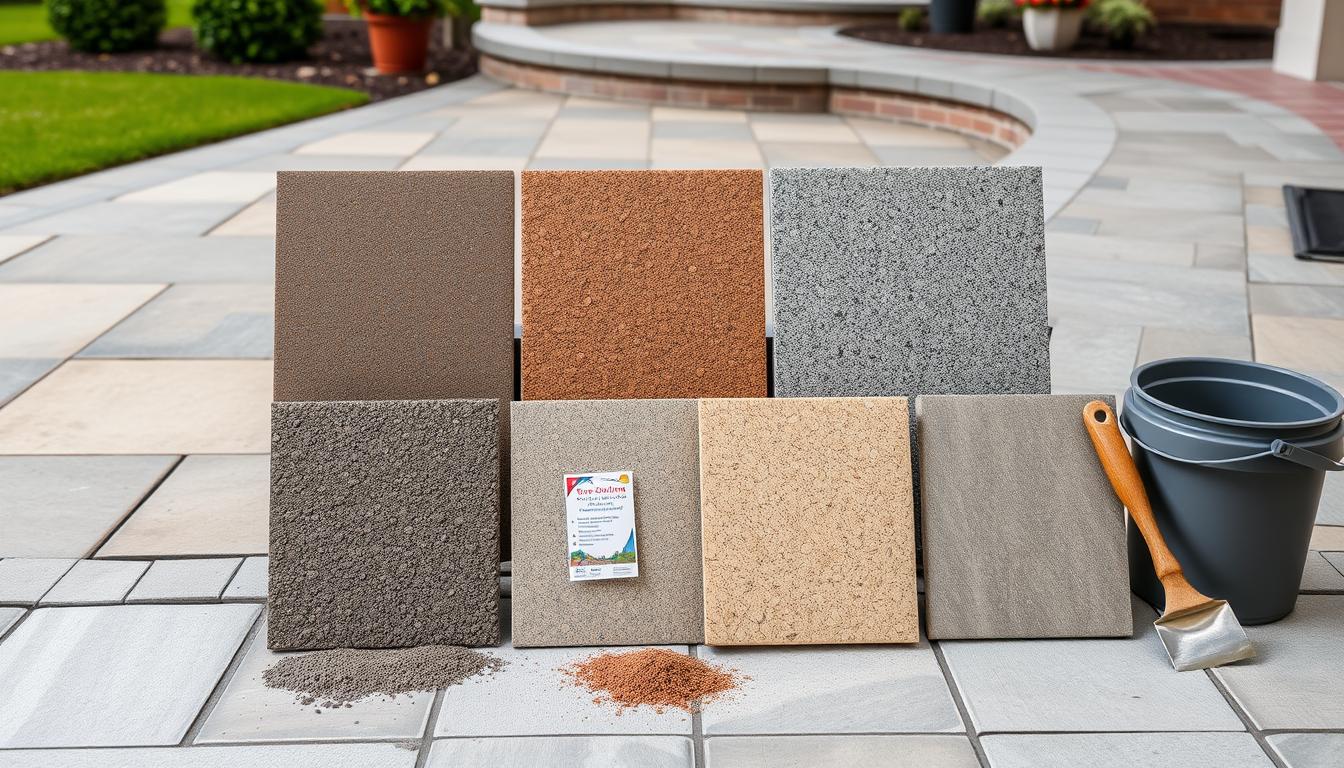
Types of Finishes Available
There are many concrete finishes to choose from. The trowel finish is great for garage and warehouse floors. It’s made by hand or with a power tool for bigger areas.
Broom finishes are perfect for driveways, sidewalks, and patios. They provide traction, making them safe when wet. Stamped concrete can look like brick or wood, adding a decorative touch. Stenciled finishes can mimic tile patterns.
Exposed aggregate reveals colorful aggregates by washing away the top layer. Salt finishing creates a textured, slip-resistant surface, great for pool decks. Grinding and polishing make glossy, slip-resistant finishes, perfect for retail spaces.
For outdoor projects, broom finishes or textured exposed aggregate improve slip resistance.
Importance of Troweling and Edging
Troweling and edging are key steps in finishing. Troweling compacts the surface, making it stronger and smoother. This step is essential for durability against the elements.
Edging defines the slab’s edge, making it look neater. Proper troweling and edging improve the surface’s look and extend its life. They help manage cracking and wear over time.
Curing Concrete Effectively
Curing is key in the concrete curing process. It lets the material reach its full strength by hydrating properly. Keeping the concrete moist is critical for its durability and strength. This ensures a strong surface for driveways, patios, and sidewalks.
What is Curing and Why is it Important?
Curing keeps the concrete moist as it hardens. This is vital for its strength and durability. Concrete gains about 70% of its strength in the first week. It takes around 28 days to fully cure under the best conditions.
If curing fails, the concrete’s strength drops, and it may crack. The success of curing depends on temperature, humidity, and the concrete’s thickness.
Methods for Curing Concrete
There are several ways to cure concrete, like wet curing, plastic sheeting, and curing compounds. Wet curing keeps the concrete moist, which is very effective. Plastic sheeting traps moisture, protecting it from evaporation.
Curing compounds also help by reducing moisture loss. The best curing happens when the temperature is between 50 and 70 degrees Fahrenheit. Humidity should be over 50% for the best results. Choosing the right curing method can make concrete last longer and perform better.
Sealing Concrete for Long-Lasting Durability
Sealing concrete is key for keeping surfaces like driveways and patios looking good and lasting long. After the concrete cures, a sealant acts as a shield against stains, moisture, and damage. There are different sealers, like penetrating and topical ones, each with its own benefits for keeping concrete in top shape.
Benefits of Sealing Concrete Surfaces
Sealing concrete brings many advantages, like making driveways more water-resistant. It can block over 80% of water, which is vital because concrete absorbs water easily. This can cause damage.
Sealing also helps prevent cracks by about 70% during cold weather. It makes surfaces last longer. Plus, sealed surfaces are easier to clean, saving time and effort.
How Often Should You Reseal?
It’s important to know when to reseal concrete to keep it protected. Most experts say to reseal every 3 to 5 years, based on the sealant and environment. Places with lots of rain or big temperature changes might need more frequent sealing.
After sealing, it’s best to wait 1 to 3 days before using the area. This lets the sealer bond well. Taking care of sealing needs helps your concrete last longer and look better. It also saves money on repairs.
Regular Maintenance of Concrete Driveways, Patios, and Sidewalks
Keeping concrete driveways, patios, and sidewalks in good shape is key. Spotting damage early can save a lot of money and make your home look better. It’s not just about looks; it’s also about safety and how well things work.
Signs That Your Concrete Needs Attention
Keep an eye out for signs your concrete might need some care. Look for cracks, color changes, and pits. Small cracks can grow due to settling, roots, or cold weather.
Ignoring these signs can lead to big problems. Fixing them early keeps your concrete looking and feeling great.
Recommended Maintenance Practices
Regular care keeps your concrete looking good and lasting longer. Clean it often to stop stains and damage. Seal it every few years to keep water out.
Fixing small cracks quickly is important. Most can be fixed if caught early. This care boosts your home’s look and extends its life.
HT Paving and Seal Coating Services Overview
HT Paving and Seal Coating Services is known for top-notch work in the Bay Area. We have over 30 years of experience. Our goal is to make sure every project is done right and meets our high standards.
Our Mission and Values
We aim to give our clients the best service possible. We focus on quality and safety in every job. We also keep improving our methods to make your concrete last longer.
Why Choose HT Paving for Your Concrete Needs?
Choosing HT Paving means you get reliable and excellent service. We’ve been doing this for 30 years. Our work can even make your property more valuable.
We offer affordable options that save you money in the long run. With the right care, your driveway can last 25-30 years or more. We also suggest sealing your surfaces every 2-3 years to keep them looking good. Trust us to do a great job.
Contact HT Paving for Expert Assistance
HT Paving is your top choice for concrete work in the Bay Area. We specialize in driveways, patios, and sidewalks. With 30 years of experience, we can handle any project size.
Whether it’s for your home or a commercial property, we deliver quality results. Our work lasts for years, improving your property’s look.
Service Areas Covered by HT Paving
HT Paving serves many areas in California. We offer top-notch concrete services to our clients. Our team provides detailed consultations and custom solutions that fit your budget.
Our success is shown in our impressive project values and many commercial clients. We are a trusted name in the industry.
How to Reach Us – Call (415) 774-6424
Ready to start your concrete project or have questions? Contact HT Paving. Call us at (415) 774-6424 to talk to our knowledgeable staff. We’re here to help with expert advice and service.
Reach out today and see the HT Paving difference for yourself!
